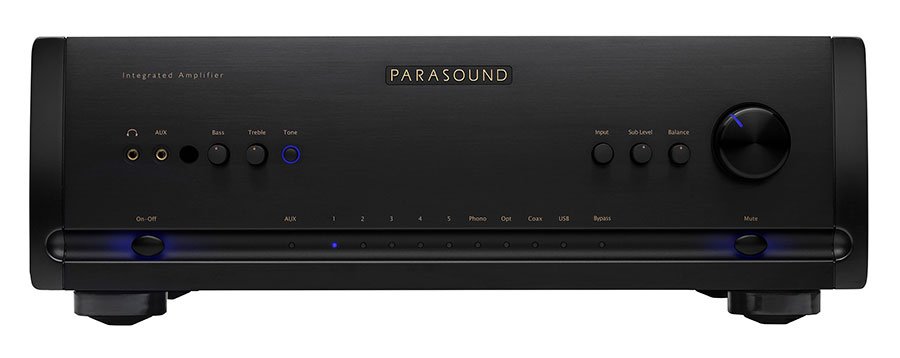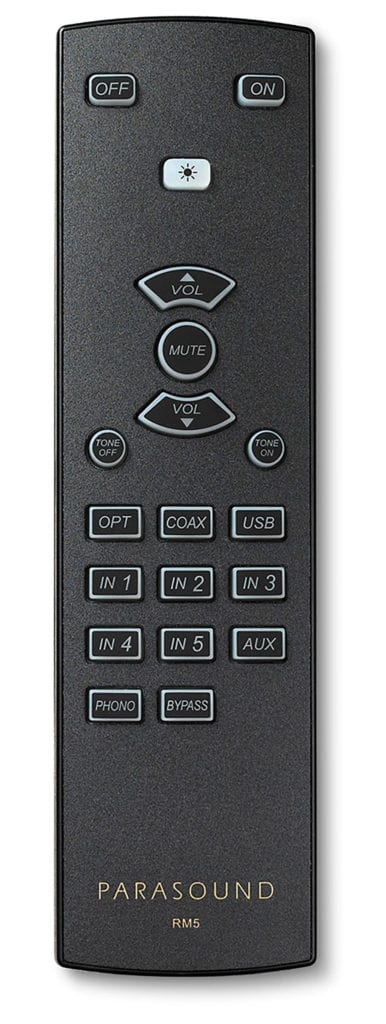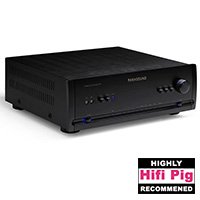The Parasound Halo 2.1 Integrated Amplifier with DAC is a fully featured integrated amplifier with an on-board DAC and much more. David Robson takes a listen to this £2999 well specified amp.
Parasound are a brand I’ve known of for many years mainly for their Pre and Power amplifier combinations, but never experienced first hand. This American brand was the brainchild of Richard Schram whose first amplifiers appeared in 1981 and were mostly sourced and built in Japan. Richard Graduated from the University of California in 1968 and spent his time in his first job in a record and Hifi shop assembling turntables and speakers. Later on Richard was accompanied by expert amplifier designer John Curl. One of Mr Curl’s claims to fame include designing master recorders for Wilson Audio and Mobile Fidelity, and the mixing consoles used in live concerts by The Grateful Dead and at the Montreux Jazz Festival in Switzerland. So the chance to review Parasounds very first integrated amplifier was something I jumped at!
CONSTRUCTION AND FEATURES
The Halo has quite a comprehensive list of components and technology fettled inside its simple, handsome outer shell. John Curl designed the topology of the power amp section of this integrated amp which also includes a DAC, Sub woofer input and crossover controls, tone controls and both MM (moving magnet, 47ohm) and MC (moving coil, 100 + 47 ohm) phono stages and five line level inputs…among others.
For those interested in the numbers, the Halo has a Class A/AB configuration with 160 watts per channel (320w total), into 8ohm, and 240wpc into 4ohm with 45amps peak current output, thus making this amp able to drive virtually any speakers out there without a fuss. It runs 4-5 watts in pure class A and the remaining 155 watts in class A/B. Inside this Parasound there is also a 1kVA fully shielded Torodial transformer with independent secondary winding for each channel. There are three digital inputs, USB, Coax and Optical – the DAC is the well received ESS Sabre 9018kzm chip, allowing the USB input to operate at 384khz/32bit , both the Optical and Digital Coax to run 192khz/24bit, and DSD256, there is no MQA support provided on this model. The drivers for computers can be downloaded online from the Parasound website and are a doddle to install.
Unboxing the amp reveals a double box with plenty of well thought out padding etc which is a good thing as the amplifier itself is a seriously weighty bit of kit, coming in at just under 20kg, it looks and feels like it means business from the off. Also provided are both US and UK power supply cables, a USB (A-B) cable, assorted 5mm cables for power trigger switch, a remote control (RC5) and a set of easily read instructions. My review sample is provided in matt black but silver is also an available option.
Out the box, fit and finish are great and what you would expect at this price point. The buttons and volume control have a tight quality feel. The smaller knobs “feel” plasticky, and are a little small.
On firing the Halo integrated up, the relays click in with a secure authority. The blue LED on the volume control ( red on mute button ) and on input selection isn’t thankfully too bright, and doesn’t glare. Other functions on the front panel, include an On/Off button, Mute button, Volume control, Input selector, Tone on/off button with the associated Bass/Treble control, a Balance control (which cannot be bypassed) and a Subwoofer level control. There also are two 5mm jacks one for headphones and an Aux input for the likes of a Phone or portable music player. (Personally I would prefer a 6.35mm jack for headphones as most quality headphones come with this as standard). The one thing I think that has been omitted from the design of the amp is a display showing what signals the DAC is receiving. As a newbie to the whole streaming game I like to know what I’m getting or playing via my digital sources. This isn’t a huge problem and not a deal breaker by any means, but would be a useful addition. On the rear panel, there are comprehensive subwoofer and crossover connections with various options available. This Parasound Halo is sold as a 2.1 amplifier that can be integrated into a home cinema system and can be adjusted and connected for that purpose but this review will concentrate on its job solely as a Hifi amplifier.
The remote control supplied with the Amp is a chunky and simple affair, the basic switching between inputs is on there, volume and mute, and there is a handy button which lights up the rubberised buttons for use in low light. You do have to point the remote control quite accurately towards the front of the amp for it to connect and work though.
SOUND
So how does this amplifier sound? Over the last few weeks I’ve played music via the digital imputs from Chromecast (optical) and Laptop via USB. I’ve connected my CD player via RCA’s and Digital Coax. The sound from the Halo from the off was lively and involving, this sound has led me to the first album up, Michael Jacksons “Thriller”. The upbeat nature of “You Gotta Be Starting something” fits the amp perfectly, the 320w gripping the drivers and pumping out the bass lines without any blur or woolyness. The rest of the party comes in as crisp and detailed, and the volume can be increased to good listening levels and the sound stays balanced and intact. “Billy Jean” has similar effects, the punch from the speakers comes with a serious kick, detail remains good with the echo-like vocals giving atmosphere and ambiance to the track. There is a very slight hardening to the upper treble on some sound effects at high volume, but this doesn’t become acidic, doesn’t seem to alter the nature of the vocals and doesn’t fatigue. As for levels of detail that this amp can reproduce, on the track “Human Nature” there is a xylophone sound that follows the verse sung my Michael that I’ve never really noticed before. Once heard it became an ear worm and the track had to be played over and over. This style of bouncy pop suits the Parasound really well. One observation is that sound stage doesn’t really escape too wide from between the speakers, instruments are accurate and where I’m expecting them to be, but within the confines of the room. Although my narrow listening space limits this effect somewhat.
Moving onto something a little more laid back and soulful. Corrine Bailley Rae’s self titled album, is awash with smooth vocals and rolling bass. “Like A Star” initiates with simple vocals and an acoustic guitar, the vocals spill out out of the speakers with a honey coated stream of emotion, the creak of the guitar strings quite evident, showing the capabilities of the Halo. The song picks up pace with a thunder-like bass that rolls out as the music picks up to a full rounded presentation. The separation from the vocals, bass, acoustic guitar and the ticking of the drums and percussion is excellent and one not seeming to influence the other. “Till it Happens To You” has my pet hate to start, fake vinyl crackle! Although this is a pain worth bearing, as the song is sublime and the Parasound lets the music flow whilst keeping all the emotion of the track intact. There is a part in the song where Corrine’s voice gets relayed as if through an old radiogram, this sound becomes completely detached and withdraws around the soundstage, but it perfectly isolates and gives a great depth to the musical vista. The Parasound Halo can add bluesy soul to its tick list too!!
I need to try and find something to see if I can trip up this great performing amplifier! Slipping in an old classic I opt for Dire Straits “Love Over Gold”. skipping directly to “Industrial Disease” a veritable selection of slamming drums, organs and sound effects. The amount of detail that the amplifier conveys to the speakers has enough to not only give depth, but again atmosphere too with the hissing sounds come from left in a realistic fashion and sitting out wide from the main stereo image. The bass drum has weight and texture, the main vocal just sits a little further back than I would like, although its clear and precise. “It never Rains” follows two tracks on – sweet and clean, the Parasound seems to take everything in its stride and takes on all comers. Only when pushed hard do vocals and high tones harden a little, we are not talking biting into lemons here, and only at obscene levels. Its composure and grip tends to stay even and enjoyable throughout.
During my travels through the listening tests I’ve swapped between feeding the Halo from my CD via RCA, digital coax and via USB of the same albums ripped to .WAV to see how the internal DAC works and sounds. I’ve also used a streaming service via optical. My findings have all been positive, the ESS Sabre sound I’m familiar with as it is the same as in my CD player. Of all the digital connections I favoured the USB fed from the Laptop, this closely matched the sound produced by the RCA.
I have also had a little play with the tone controls – I found that when the tone controls where switched into circuit that the amp immediately lost some upper level of realism, it just stopped sounding as special as it had to my ears. I’m not an anti tone control guy by any means as I thought the ones used on the older Audiolab amplifiers of years back worked well. When you start to adjust and mess with the bass and treble it just unbalances the whole demeanor of what is a great standard of sound and the controls unfortunately don’t really have a positive impact on sound. Thankfully once turned off the amp falls back into what it does best and gets on with producing, “great music”.
CONCLUSION
This is a great sounding amplifier! It has plenty of versatility, and many strings to its bow. The DAC section works well. The fact you can use this amplifier as part of an A/V system, and add on a Subwoofer or just use it as a stereo lynch-pin says a lot about just how much Parasound have got right with their first integrated. I feel I would swap out those tone controls for an extra digital coax and optical input for today’s needs and some sort of wireless connectivity option would be a bonus also. These are minor personal design gripes for what is a fantastic sounding and entertaining piece piece of kit.
AT A GLANCE
Build Quality: A solid and well put together Amplifier with a handsome presence. Well laid out fascia and easy to use remote.
Sound Quality: The Parasound does great music making everything sound effortless, it has a dynamic and powerful presentation that will work well with virtually any genre
Value For Money: A well specified and feature laden amplifier. Which in turn can be the keystone and heart of a great sounding system making this a good value purchase
Pros: Great sound, good bass grip and sweet informative treble, tons of musicality. Lots of connectivity and options to play with
Cons: Unnecessary tone controls, too few digital inputs, and a larger headphone input would be nice. I’d also like to see some sort of display for digital input frequencies on the front panel
Price: £2999
David Robson









































































































































































































You must be logged in to leave a reply.